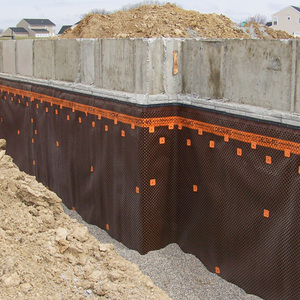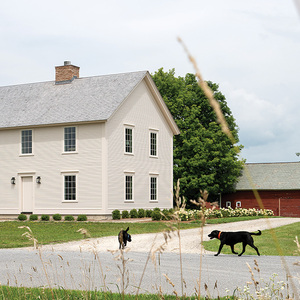I asked this a while ago but didn’t get much response. Winter is coming, so I thought I’d throw it out one more time…
I’ve spent the summer pulling out most of the brickmoulding around the windows on two sides of the house and replacing it with new moulding + stripping, epoxying and repainting the sills where necessary.
Part of that process involved ripping out the old storms that were caulked in with what appeared to be industrial adhesive ;o) So, they didn’t survive the tear-out. (They were ugly anyways).
So, now I need to figure out what I should replace them with. The window framing is original to the house, with replacement sashes (double-hungs) that are probably no more than a decade old. They’re OK, but far from air tight. The old storms (the screen/window combo units) weren’t a whole lot of help in terms of weatherproofing.
So…my questions…are storms meant to act as weather proofing against cold air or are they simply meant to keep the wet away from the windows? If they do offer some weather proofing, would it make sense to look into the seasonal window/screens that you swap out come fall…it would seem that those windows would give a true seal.
At this point, if the storms are really just to keep rain out, I’m probably going to forgo storms (since we have awnings anyways) and just get screens for summer. If they do offer some protection against the cold, do the seasonal storms offer better insulation than the combo units (I assume they do…but maybe there are some excellent brands of combo-units out there). The only advantage of the combo units is that you can close them when a storm comes in the summer. Otherwise, I find them really ugly from the outside.



















Replies
Locally storm windows imply aluminum! Often gawdy, but convenient for a quick change between screen and storm glass.
Absolutely no insulating value and limited infiltration value....which leaves them being only a weathershield from the rain/snow.
Aluminum storm repairs can be labor intensive if parts are available.
The best looking ones are the "blind stop"....as opposed to "overlap" which set on top of the brickmould. The blind stop type allow for more visual shadow lines to keep the windows architectural look.
If you buy new storms (aluminum)...don't glue then in place.
If you decide to build wooden storms and screens, you have some work ahead of you. Plus you will need a storage area for the windows that have both screen and storms.
....................Iron Helix
Are there companies that make the replaceable/seasonal storms out of aluminum, or is wood the way to go? I don't think building wood ones would be worth the effort (I'll just stick with 3M shrink wrap in winter until we replace the windows). I haven't done a lot of research yet, but the companies I've talked to thus far pretty much just make the combo units.
You don't say what material these 10 YO replacement sashes are nor whether they're single or double glazed, but I'm going to presume wood, single glazed. Without storms of some type, you're leaving those wood sashes to battle with the forces of nature. Their effective life expectancy will be drastically shortened as a result.
That being said, installing storms is no guarantee that you're doing the double hungs any big favor IF water vapor from the inside of the house can migrate in between the primes and the storms and condense there. Little terarrium then and so sealing up/weatherstripping to prevent this important. Unless of course you use the aluminum track storms as these usually don't seal tight enough that trapped condensation is a problem.
Nonetheless, I'd recommend that you install the storms and tighten up those sashes so that you eliminate migrating water vapor the absolute best you can.........unless you intend to replace all the windows in the near-ish future. Then let those primes take a beating and it won't matter............except to your heating and cooling bill.
Besides being worthless as far as having insulating value (and being downright ugly on an older home), improperly mounted aluminum storms can raise havoc with your sill and bottom end of the jambs. I've seen alot of this and I'm sure others here have, too. The weep holes along the bottom are caulked or painted shut and then rainwater collects in there if a bottom window is left open in the warmer months. Rot city.
If you don't care to build wooden storms for these windows, then you might also consider vinyl double-glazed replacement sash paks, if the jambs and sills are in good shape.
If you do decide to build storms, I'd advise using good strong joinery and a polyurethane glue for assembly. Fit them so that the bottom rail of the window is 3/16" or so off the sill or they'll wick water and do themselves in over time as a result.
There.....I'm outta wind so I'll shut up now and get another cup of coffee.
It ain't that tough. <g>
Knowledge is power, but only if applied in a timely fashion.
"You don't say what material these 10 YO replacement sashes are nor whether they're single or double glazed, but I'm going to presume wood, single glazed."
Wood, double glazed. Just not very air tight where the two sashes meet (these don't appear to be high-end sash replacements and/or just not installed that well in old, slightly out-of-square frames)
"Without storms of some type, you're leaving those wood sashes to battle with the forces of nature. Their effective life expectancy will be drastically shortened as a result."
Understood. However, we have awnings on these windows during the summer months, keeping a good part of the rain off. Winter, well, that's a different story, of course... ;o)
"Unless of course you use the aluminum track storms as these usually don't seal tight enough that trapped condensation is a problem. "
yea, that's what we had, so maybe that's a good thing. I hadn't considered the condensation issue...It hasn't been a big problem, though more likely due to the fact that the house is really dry in the winter time.
"Rot city. "
Yep...hence my fun this summer fixing it all ;o)
Thanks for the advice. It sounds like one shouldn't count on storms as weatherproofing for cold, but merely a protection against, well, storms from beating the windows.
Related to that, we did replace one set of double-width windows with some Marvins. These were wood windows. They seal MUCH tigheter than the old ones, so I'm thinking weatherproofing for cold won't be as much of an issue. Marvin also stated that these windows don't need storms. Is there a specific reason why they wouldn't need storms, but many people use storms on like-windows? (other than a conspiracy theory that Marvin wants the windows to wear out sooner so I replace them? ;o)
I believe that the storm sash actually does have a small insulating effect by cutting the wind against the window and creating a dead air space. Basically, the same way an unheated mud room protects an entry from wind. You definetly need a small gap at the bottom(I use 1/8") to allow condensation to dissapate and let the window frame dry.
I think it is either Marvin or Pella who sells a single glazed window with a removeable storm panel. At least they used to a few years ago when I was still carpen' it.
Sorry if I gave you the impresion that wood storms also have no insulative value.......because they do. And quite alot of it. It's the aluminum jobs that don't offer very much at all.
Come to my house (1875 Vic) and I'll pull one off on a cold night. Then lay your hand on one with a storm and one without. They'll be no doubt in your mind from that point forward.
Traditonally many wooden storms were equipped with breather/venting holes bored in the lower sash and then covered with a hinged wooden cover plate. Something on the order of three holes about 1" dia. or so. On warmer days during the winter, one could swing this little cover open and supposedly vent out some or all of any condensed moisture trapped between the primes and the storm. I've personally never seen this work worth a hoot. Primarily I think because there is no chimney effect unless you also bore holes in the top rail of the window and I've never seen this done. Top rails are generally too small to allow as large of a hole and so flow would be restricted to the smaller size anyway.
Some old storms were equipped with a piece of hardware that served as a "propping device". This held the bottom of the entire storm open for the same purpose. As you can imagine, this requires that the storm is top hung with storm hanging hardware. Much more effective, but still a hassle to do.
I guess I still think from experience that the best approach is to prevent the migration of water vapor into the area between the windows rather than try to get rid of it after it's there. From the sounds of it, that may not be too terribly difficult for you to do.
Here's one source for weatherstripping.........
http://www.aresource.com
If you like, you could also use a caulk product called Seal & Peel. This stuff will stop all drafts and prevent vapor migration if you're thorough when you apply. It's a clear temorary caulk that is nearly invisble. As the name implies, it peels out again very easily (like a rubberband) without damaging the paint or finish underneath. However, I would caution you against either laying too small of a bead making it difficult to get hold of at removal time or leaving it in place for more than two years. After that 2 years, it begins to degrade in a manner that makes removal more difficult. Best practice is new every year. There are similar products out there if you can't find the Seal & Peel. The Seal & Peel has a lacquer thinnner strong odor for the first 6 hours or so after application, so bear that in mind and don't apply it in your bedroom an hour before you intend to retire or in the dining room an hour before the boss is coming for supper.
If trying to prevent vapor migration between the windows,don't forget it can get there around the window trim as well. A little caulking and painting may be in your future.
Sure, any wooden window will benefit from the protection of a storm whether single or double glazed. More insulative value, too.
Maybe Marvin sash paks are in your future if your jambs and sills are in good shape. Damn good product and usually alot less expense than total replacement.
Edit: Some folks don't want to "hang" their exterior storms but rather just "hold" them in. In these instances, a couple of screws placed in the bottom of the bottom rail will act as feet to insure that gap at the bottom.
Knowledge is power, but only if applied in a timely fashion.
Edited 9/19/2003 9:25:09 PM ET by GOLDHILLER
We have a combination of wood and aluminum storms - 1873 Italianate - and want to go all wood. Your post is very timely. Several questions
Do you have a source for top hung wood storm hardware? and muntins?
Thanks
I acquire hanging hardware at the local Menard's.
Ideal Security Hardware - 56-2213 = storm window hangars (or at least that's the number on the last batch I bought some time back)
I believe National Hardware also makes a hanger which is literally interchangeable with the Ideal.
Google a search = storm window hardware. Hits will include some to a few different "antique hardware" sources. One of those may well be another source and may have different types of hardware available, but I've never used anything beyond the basic hardware above because it met my needs and was readily available locally.
Source for muntins? No, as I've never looked for one. I always make the entire window from scratch. Buying the muttins doesn't seem practical to me.
It would seem that if you did find a source for just muttins, they would have to be a very simple profile, e.g. square..... to be useful to you. If the ends of the muttins were coped, you would have to have a mating bit with which to mill your rails and stiles. Square or rectangular is so easy to make that it wouldn't pay to look for them, I would think.
If you built and assembled your windows with square or rectangular muttins, stiles and rails, you can then use a router to do the profiling after assembly. Yield will be radiused corners instead of the square corners seen in coped and sticked joints. On the inside of the window, this looks fine although just a bit different than traditional. On the exterior side where you would rabbet for the glass, you simply chop out those radiused corners with a chisel to receive the glass.
Edit: Forgot something...as per usual it seems. When I mount large storms, I usually use small hooks and eyes at the bottom of the window (inside of window) into the bottom rail and the sill.......and a pair of those "butterfly/bowtie" type turning stays in the middle on the outside...in addition to the top hanging hardware.
This makes for a well secured large storm window. I've seen storms out here in the country with less on them get sucked right off the house in a winter or spring storm with sustained strong winds.
If you missed this recent thread, it may be useful to you also.
http://forums.taunton.com/tp-breaktime/messages?msg=35063.1
Knowledge is power, but only if applied in a timely fashion.
Edited 9/29/2003 10:21:03 AM ET by GOLDHILLER
Edited 9/29/2003 10:52:56 AM ET by GOLDHILLER
Thank you for the information on the hardware and how you go about making the muntins. The window repair post is great. I have a tip that has worked well for me.
Removing old glazing compound.
Use 100% parafin oil - lamp oil - paint a liberal coat of oil on the glazing including where it meets the glass and the muntin [I use acid brushes] wait a few minutes you can see the color of the glazing darken as it absorbs the oil. You may need to apply more than one coat After the glazing has darkened it maybe picked off with a putty knife in sections of up to several inches long.
My speculation is the oil penetrates under the glazing and loosens it's grip on the glass. In any case this has saved me hours on hours of work. Simce I have used this method no more broken 130 year old glass.
Thank you for the tip. I will definitely give that a try next time.
The "after assembly" routering technique of milling the profiles on storm windows is one which IMO yields a really decent look for someone who only has a smaller router and/or doesn't have sticking and coping bits nor a shaper with said.
It's fast and easy and therefore more affordable when you have only a few storms to make for either yourself or a customer (no time spent setting up a shaper).
It might not pass muster for a strictly historical restoration project, but most storms don't have to pass that critique with the homeowner.
Knowledge is power, but only if applied in a timely fashion.
I expected to see a chunk of plywood screwed to a window frame with drywall screws.
; )
A good heart embiggins even the smallest person.
Quittin' Time
"I expected to see a chunk of plywood screwed to a window frame with drywall screws."
Dude.......
Sorry to disappoint, but when you showed me that trick........
well.....I really didn't think it would be good for business if I followed suit.
My customers would, at the very least, insist on stainless screws. ;-)
Knowledge is power, but only if applied in a timely fashion.
ROFLOL
Yeah, I know. Some customers can be really demanding.
Can you believe that some customers actualy want to be able to see through their storm windows ?
I Just don't know how I ever coped with such demands.
; )
A good heart embiggins even the smallest person.
Quittin' Time